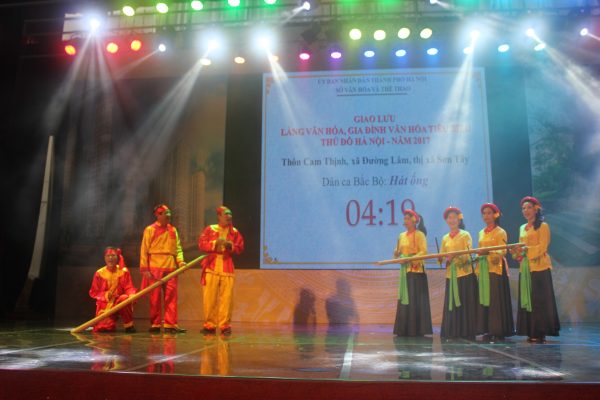At present, Hanoi has 1,401 cultural villages. The cultural village movement has contributed to the preservation of the Thang Long – Hanoi culture and Doai culture, creating a healthy cultural environment in rural areas. The 2017 Capital City’s Cultural Village and Cultural Family Exchange Event showed that many traditional cultural traits have been preserved and promoted in cultural villages.

The Chau Van (poetic musical) performance of “Co Doi Thuong Ngan” (“Lady Doi of the Mountains”) of the performance team of Luong Quy Village, Xuan Non Commune, Dong Anh Distrct.
There are only a few village-level cultural exchange events where the audiences are “mesmerized” until the last minutes, and the 2017 Capital City’s Cultural Village and Cultural Family Exchange Event was one of them. The event took the audiences by surprise with the enormous number of cultural treasures preserved by the people as well as the love for art, especially traditional art, in the suburb areas. One of the most impressive performances was the Chau Van (poetic musical) performance of “Co Doi Thuong Ngan” (“Lady Doi of the Mountains”) of the performance team of Luong Quy Village, Xuan Non Commune, Dong Anh Distrct. The farmer-artists with inspiring and emotional voices played the roles brilliantly, helping the public understand more about the “Worship of Mother Goddesses” cultural heritage. Due to the area’s large number of cultural clubs with various routinely cultural activities, it was difficult for the people of Luong Quy Village to choose a single performance to represent Dong Anh District at the cultural event. The various well-known cultural clubs in Luong Quy include Classical Drama Club; Classical Drama Club of the Youth (for teens and children); Folk Song Club; Poetic Musical Club; Kylin, Lion, and Dragon Dance Club, and so on. Even though the art of classic drama has the richest tradition and the Classical Drama Club has the most number of members, the time frame for the performance is limited, rendering the decision of choosing a Chau Van (poetic musical) performance for the event. In Luong Quy, many families have three generations participating in classical drama performing or are member of various clubs. During the festive reason, it’s only common to find a whole Luong Quy family performing arts together.

Bamboo-tube Northern Folk Singing performance of the performance team of Cam Thinh Village, Duong Lam Commune, Son Tay Town.
Luong Quy was one of the 15 typical cultural villages representing 14 suburban districts of Hanoi at the exchange event. With the cultural performances alone, the villages were able to showcase the richness of traditional culture of Thang Long – Hanoi. Khanh Van Village (Khanh Ha Commune, Thuong Tin District) impressed the audiences with a Trong Quan (traditional military drum) performance, a special descant originated in Thuong Tin, Phuc Tho. Once thought to be lost, the Trong Quan descant through the performance of a very young artiste had shown not only was it revived, but it also gained its own development momentum. Other unique traditional performances were the Bamboo-tube Folk Singing performance (Cam Thinh Village, Duong Lam Commune, Son Tay Town), Cheo (satirical theatre) performance (Hoang Duong Village, Son Cong Commune, Ung Hoa District), Gong Dance performance (Thuong Village, Yen Binh Commune, Thach That District), and so on. Each locality brought to the event its own cultural color, but all the same showed that the cultural life of many villages had changed and traditional culture and arts had been preserved and promoted through the cultural village movement.
The city has built cultural village models, cultural residential quarters, and cultural families to concretize the objectives of Program No.4 of Hanoi Municipal Party Committee on “Developing culturally and socially, enhancing the quality of human resources of the capital city, creating the impression of elegant and civilized behaviors of Hanoians in the period 2016-2020”. At present, Hanoi has 1,401 cultural villages, actively contributing to the preservation of the Thang Long – Hanoi culture and Doai culture, creating a cultural environment for human development and prevention of cultural issues. The actual construction of cultural models has, however, shown certain inadequacies. Some localities have cultural traditions but are unable to develop socially and economically. Xuan Non Commune is a typical example. Contrary to its booming cultural movement which had been deployed for quite some time, the commune performed poorly at the beginning of the new rural construction program with only 2 out of 19 achieved. The “difference” between cultural and socio-economic development then was huge. Since the start of the new rural construction program, the way of doing business has changed and the economy has developed. The villagers have not only donated land to build roads but also contributed to the construction of concrete roads. At present, 90% of households in the commune have been recognized as cultural families, the people’s living standards have been improved, and the number of rich and affluent households has increased significantly. As discussed at the 2017 Capital City’s Cultural Village and Cultural Family Exchange Event, the most important lesson is that the areas with more effective combinations of cultural village movements and new rural area construction movements are usually more comprehensively-developed in terms of economy, culture, and society. Regarding this observation, Yen Vy Village (Huong Son Commune, My Duc District) is a typical example. Through the construction of new rural areas, a spacious two-storey cultural house has been built with a reading room capable of providing over 2,000 book titles to the villagers. Renovated works have also been carried out at relics within the area, establishing a good foundation for the people to build their cultural life and enrich the cultural activities.
It can be pointed out that the combination of the cultural village movement and the new rural area construction movement has promoted economic and social development, contributing to the quality of life as well as raising awareness and enhancing the preservation and promotion of cultural and national values in rural areas.
Giang Nam

